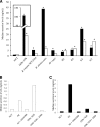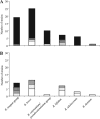Characterization of immunostimulatory CpG-rich sequences from different Bifidobacterium species
- PMID: 20208019
- PMCID: PMC2863467
- DOI: 10.1128/AEM.01714-09
Characterization of immunostimulatory CpG-rich sequences from different Bifidobacterium species
Abstract
The beneficial effects of Bifidobacterium are partly due to its immunostimulatory properties. These immunostimulatory properties may be linked to the presence of unmethylated CpG motifs specific to bacterial DNA, which may induce a TH1 response by activating Toll-like receptors (TLR). Using in silico analyses, PCR amplification, and dot blotting, we characterized the CpG content of various bifidobacterial strains and evaluated the immunostimulatory properties and genomic heterogeneity of these motifs in the genus. Our in silico study, based on entire genome sequences from five bifidobacterial strains, showed that Bifidobacterium genomes contain numerous CpG motifs, including 5'-purine-purine-CG-pyrimidine-pyrimidine-3' and 5'-purine-TCG-pyrimidine-pyrimidine-3' motifs, and biologically active sequences previously identified in lactic acid bacteria. We identified four CpG-rich sequences with Bifidobacterium longum NCC2705. Two sequences with a percent G+C of about 68% included 14 and 16 CpG motifs. Two sequences with a percent G+C of about 60% included 16 and 6 CpG motifs. These sequences induce the production of monocyte chemoattractant protein 1 (MCP-1) and tumor necrosis factor alpha (TNF-alpha) through a pattern of TLR9 stimulation on RAW 264.7 macrophages. No link could be established between their immunostimulatory properties, the number of CpG motifs, and percent G+C. We investigated inter- and intraspecies heterogeneity in 71 strains of various origins. These sequences were highly conserved in the genus. No link was found between the presence of the CpG-rich sequence and the origin of the strains (healthy, allergic, or preterm infants). The high frequency of CpG motifs in the DNA of Bifidobacterium may play an important role in the immunostimulatory properties of commensal or probiotic bifidobacterial strains.
Figures



 , > 80%;
, > 80%;  , < 80%.
, < 80%.  , insertion into sequence;
, insertion into sequence;  , deletion from sequence. Bli 15697, B. longum subsp. infantis ATCC 15697; Bal AD011, B. animalis subsp. lactis AD011.
, deletion from sequence. Bli 15697, B. longum subsp. infantis ATCC 15697; Bal AD011, B. animalis subsp. lactis AD011.


Similar articles
-
CpG oligodeoxynucleotides as DNA adjuvants in vertebrates and their applications in immunotherapy.Int Immunopharmacol. 2006 Oct;6(10):1586-96. doi: 10.1016/j.intimp.2006.06.001. Epub 2006 Jun 28. Int Immunopharmacol. 2006. PMID: 16919831
-
CpG-containing oligodeoxynucleotides induce TNF-alpha and IL-6 production but not degranulation from murine bone marrow-derived mast cells.J Leukoc Biol. 2001 Feb;69(2):253-62. J Leukoc Biol. 2001. PMID: 11272276
-
Immunostimulatory CpG motifs in the genomes of gut bacteria and their role in human health and disease.J Med Microbiol. 2014 Feb;63(Pt 2):293-308. doi: 10.1099/jmm.0.064220-0. Epub 2013 Nov 19. J Med Microbiol. 2014. PMID: 24255136
-
Discovery of immunostimulatory CpG-DNA and its application to tuberculosis vaccine development.Jpn J Infect Dis. 2002 Apr;55(2):37-44. Jpn J Infect Dis. 2002. PMID: 12082305 Review.
-
Modulation of Toll-like Receptor 9 Responses through Synthetic Immunostimulatory Motifs of DNA.Ann N Y Acad Sci. 2003 Dec;1002:30-42. doi: 10.1196/annals.1281.005. Ann N Y Acad Sci. 2003. PMID: 14751820 Review.
Cited by
-
Complete Genome Sequence of Bifidobacterium longum GT15: Identification and Characterization of Unique and Global Regulatory Genes.Microb Ecol. 2015 Oct;70(3):819-34. doi: 10.1007/s00248-015-0603-x. Epub 2015 Apr 17. Microb Ecol. 2015. PMID: 25894918
-
In vivo Trial of Bifidobacterium longum Revealed the Complex Network Correlations Between Gut Microbiota and Health Promotional Effects.Front Microbiol. 2022 Jun 17;13:886934. doi: 10.3389/fmicb.2022.886934. eCollection 2022. Front Microbiol. 2022. PMID: 35783421 Free PMC article.
-
Kiwifruit (Actinidia deliciosa) changes intestinal microbial profile.Microb Ecol Health Dis. 2012 Jun 18;23. doi: 10.3402/mehd.v23i0.18572. eCollection 2012. Microb Ecol Health Dis. 2012. PMID: 23990838 Free PMC article.
-
Gut microbiota-dependent modulation of innate immunity and lymph node remodeling affects cardiac allograft outcomes.JCI Insight. 2018 Oct 4;3(19):e121045. doi: 10.1172/jci.insight.121045. JCI Insight. 2018. PMID: 30282817 Free PMC article.
-
Probiotics Mechanism of Action on Immune Cells and Beneficial Effects on Human Health.Cells. 2023 Jan 2;12(1):184. doi: 10.3390/cells12010184. Cells. 2023. PMID: 36611977 Free PMC article. Review.
References
-
- Alfaleh, K., and D. Bassler. 2008. Probiotics for prevention of necrotizing enterocolitis in preterm infants. Cochrane Database Syst. Rev. 23:CD005496. - PubMed
-
- Amrouche, T., Y. Boutin, G. Prioult, and I. Fliss. 2006. Effects of bifidobacterial cytoplasm, cell wall and exopolysaccharide on mouse lymphocyte proliferation and cytokine production. Int. Dairy J. 16:70-80.
-
- Ashkar, A. A., and K. L. Rosenthal. 2002. Toll-like receptor 9, CpG DNA and innate immunity. Curr. Mol. Med. 2:545-556. - PubMed
-
- Butel, M. J., N. Roland, A. Hibert, F. Popot, A. Favre, A. C. Tessèdre, M. Bensaada, A. Rimbault, and O. Szylit. 1998. Clostridial pathogenicity in experimental necrotising enterocolitis in gnotobiotic quails and protective role of bifidobacteria. J. Med. Microbiol. 47:391-399. - PubMed
Publication types
MeSH terms
Substances
LinkOut - more resources
Full Text Sources
Other Literature Sources
Molecular Biology Databases
Research Materials
Miscellaneous

